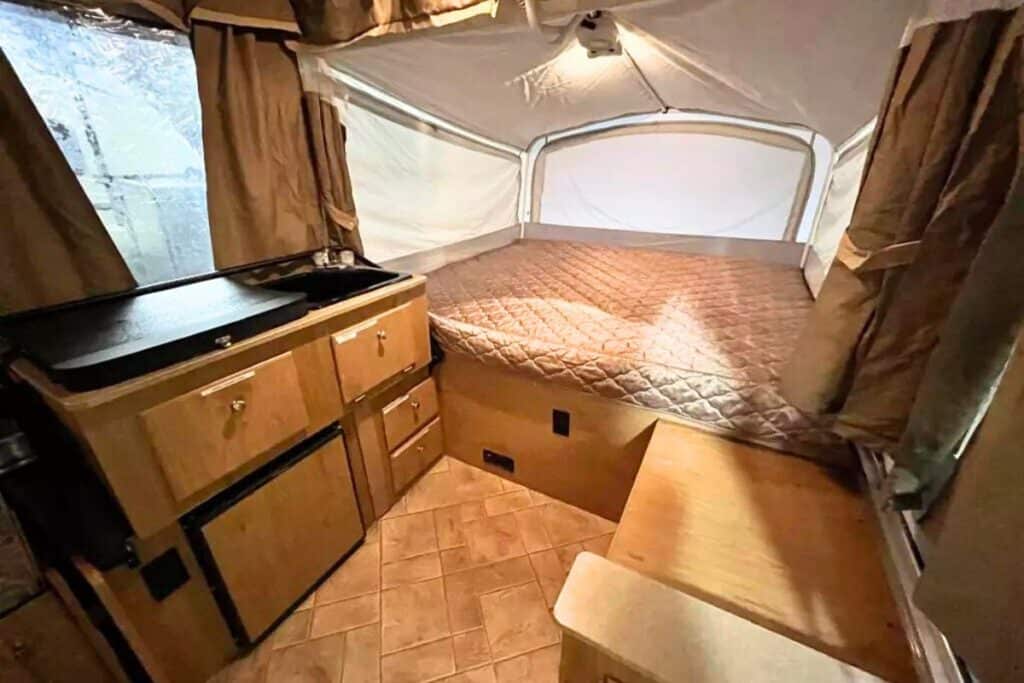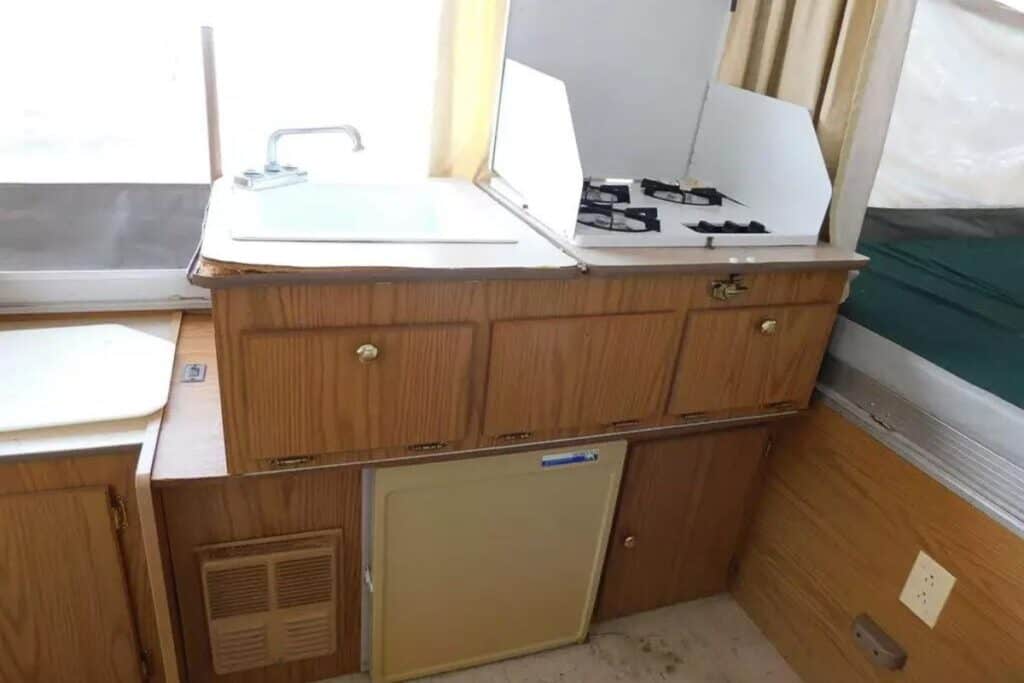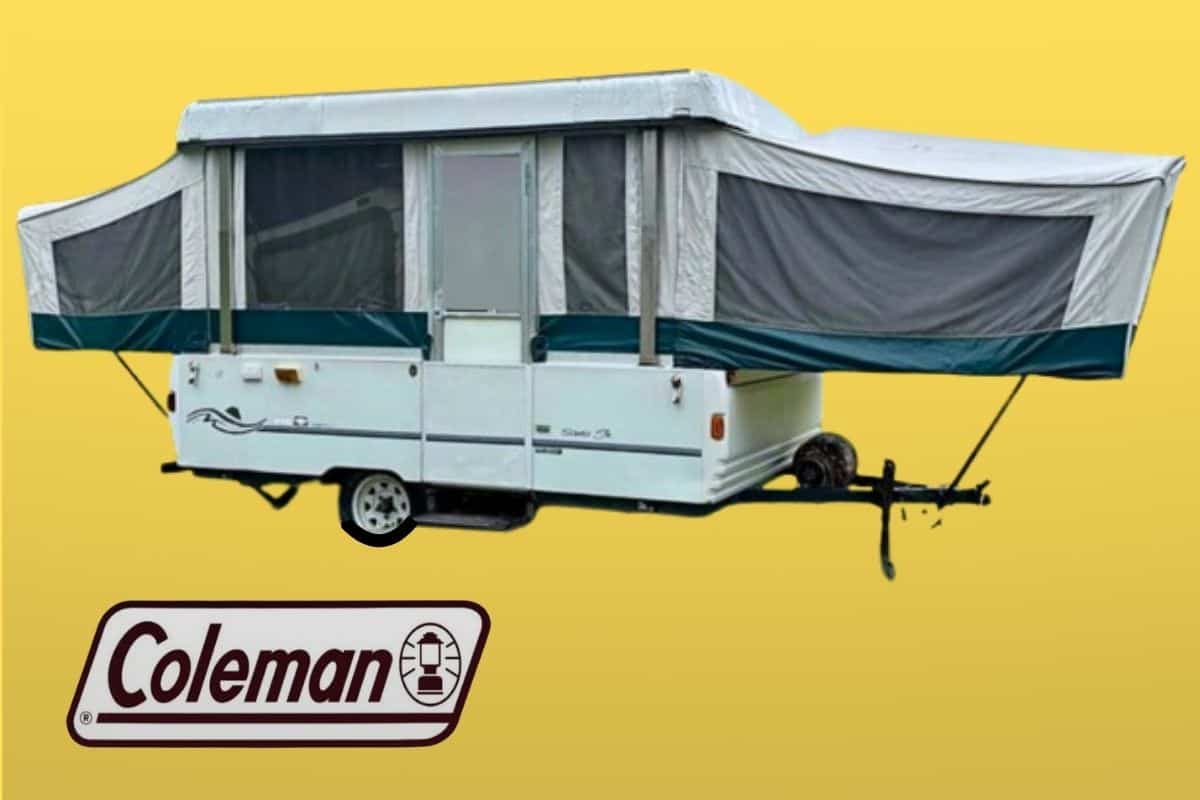Thinking about hitting the open road in a Coleman pop-up camper?
If so, you’re not alone, as these classic pop-ups have been a favorite among campers for decades, thanks to their affordable price, simple design, and ease of towing.
Offering everything you need in a pop-up and nothing you don’t.
But before you start dreaming of cozy nights under the stars in your very own Coleman pop-up, there are some things you should know first.
From their rich history and production run to practical considerations like weight, cost, and features.
1. When Did Coleman Start Making Pop-Ups?
Coleman, a name synonymous with outdoor gear founded in 1900, made quite a splash when they entered the pop-up camper market.
Coleman’s entry into pop-up campers or folding trailers as they were called began in 1966 when they created their folding trailer division. This marked a significant expansion for a company already well-known for its camping gear.
Their reputation for quality and innovation in camping equipment naturally extended to their line of folding trailers, making them a trusted brand from the beginning.
Coleman’s first pop-up models hit the market in 1967, quickly gaining traction among outdoor enthusiasts. These early Coleman pop-up campers were a game-changer, offering:
- Affordability: Priced lower than many competitor trailers
- Ease of towing: Light enough for many family cars to handle
- Quick setup: Could be ready for camping in minutes
- Coleman’s trusted name: Backed by a brand campers already knew and loved
By the mid-1970s and through the 1980s and 1990s, Coleman pop-up campers were some of the most popular models on the market and a common sight in campgrounds across America.
2. When Did Coleman Stop Making Pop-ups?
The Coleman brand in the pop-up camper market ended in 2011, marking the close of a 44-year chapter that had seen these iconic campers become a staple of American camping culture.
The decision to halt production wasn’t made lightly, and it left many outdoor enthusiasts wondering why their favorite brand was exiting the scene.
Let’s break down the timeline and reasons behind Coleman’s departure from the pop-up world:
- The Lead-Up: In the early 2000s, Coleman’s RV division faced increasing competition and changing market dynamics. The company had already sold its RV division to Fleetwood Enterprises in 1989 but they continued to license the Coleman name for pop-up campers.
- The Final Years: Fleetwood sold the Fleetwood Folding Trailers Division to Blackstreet Capital Partners LLC, which was renamed FTCA (Folding Trailer Company Acquisition Inc.). From 2008 to 2011, Coleman pop-ups were manufactured by FTCA Inc., which signed a new trademark licensing agreement with Coleman in 2008. During this period, production continued, but at a reduced scale.
- The End of an Era: In 2011, FTCA Inc. announced it would cease operations, effectively ending the production of Coleman-branded pop-up campers.
Why Did Coleman Stop Making Pop-ups?
There are several reasons why Coleman stopped making pop-up campers:
- Coleman the Company: The Coleman Company has not produced pop-up campers since 1989 when it sold its folding trailer division to Fleetwood Enterprises.
- Economic Downturn: The 2008 financial crisis hit the RV industry hard, leading to decreased demand and financial struggles for many RV manufacturers, including Fleetwood, who was licensing the Coleman brand name.
- Changing Consumer Preferences: There was a shift towards larger RVs and more luxurious camping experiences, putting pressure on the pop-up camper market. This continues to this day, as only a few major RV manufacturers still produce pop-ups, including Forest River and Coachmen.
It’s worth noting that the Coleman brand name still exists in the RV market, as Dutchmen RV still produces a line of travel trailers under the Coleman brand (more on this later).
3. How Many Coleman Pop-up Camper Models Are There?

Over the 44-year history of Coleman pop-up campers, Coleman and the RV manufacturers licensing the brand name introduced countless models, constantly evolving to meet campers’ changing needs and preferences.
The number of Coleman pop-up camper models is staggering, with dozens of unique names and configurations hitting the market over the decades.
Throughout its history, Coleman produced over 100 different pop-up camper models and trim levels. However, the constant introduction of new models and the retirement of others makes it challenging to give an exact count.
A Brief History of Coleman Pop-up Camper Models:
Below is a brief history of all the major Coleman pop-up camper models released over the years:
Early Years (1967-1971)
Coleman pop-ups started with the CT series:
- 1967: CT-160, CT-161, CT-170, CT-171, CT-172, CT-180, CT-190
- By 1970: CT-460, CT-470, CT-480, CT-481, CT-482, CT-490
- 1971: The “CT” prefix was dropped, using just numbers like 570, 580, 581, 582, 590, 596
The Name Game Begins (1972-1979)
Coleman started using catchy names for their models, often with patriotic themes:
- 1973: Somerset, Valley Forge, Brandywine, Brandywine II, Yorktown
- 1975-1977: Added models like Minuteman, Settler, Lexington, Patriot
- 1978: Introduced Gettysburg, Saratoga, Concord, Rebel, Ticonderoga
The Sun Series (1980)
A brief departure with models like Sun Classic, Sun Sprite, Sun Haven, and Sun Lite
1980s Expansion
Coleman broadened its lineup with models like:
- Colonial, Niagara, Shenandoah, Williamsburg, Sequoia, Sun Valley
- Later additions: Redwood, Liberty, Cape Cod, Aspen, Newport, Laramie
1990s Diversification
Coleman organized its models into series:
- Americana Series: Brandywine, Grandview, Sequoia
- Colorado Series: Colorado, Colorado Sport
- Destiny Series: Cedar, Roanoke, Royale
- Pioneer Series: Arcadia, Chesapeake, Newport
Late 1990s to 2000s
The lineup continued to evolve with series like:
- Grand Tour Series: Key West, Niagara, Sun Valley
- Grand Tour Elite Series: Bayside, Niagara, Monterey
Final Years (2008-2011)
After Fleetwood stopped using the Coleman brand in 2003, the mantel was picked back up by FTCA Inc. who introduced models like:
- Highlander Series: Avalon, Niagara
- Evolution Series: E1, E3, Cobalt (Toy Hauler Pop-ups)
- Americana Series: Utah, Bayside
- Americana LE Series: Sun Valley, Santa Fe, Cheyenne
- Destiny Series: Sedona, Yuma, Westlake Limited Edition
4. What are the Best Coleman Pop-up Camper Models?
Throughout its production history, Coleman offered a wide range of pop-up camper models, each with unique features catering to different camping needs.
While personal preferences vary, several models stood out over the years for their quality, features, and popularity among campers.
Below are some of the most popular models and our personal favorites:
- Coleman Bayside (Americana Series)
- Highlights: AC, ample storage, slide-out dinette
- Best for: Families seeking comfort and practicality
- Coleman Avalon (Highlander Series)
- Highlights: Spacious interior, shower, ample storage, power lift kit
- Best for: Large families looking for luxury
- Coleman Sedona (Destiny Series)
- Highlights: Lightweight, easy to tow, essential amenities
- Best for: Those seeking simplicity
- Coleman Saratoga (Highlander Series)
- Highlights: Comfortable layout, built-in music system, ample storage
- Best for: Those wanting luxury in a more manageable size
- Coleman Sun Valley (Americana Series)
- Highlights: Durable construction, AC, high sleeping capacity
- Best for: Those prioritizing value and essential features
- Coleman Westlake (Destiny Series)
- Highlights: Spacious interior, quality canvas, outdoor shower
- Best for: Budget-conscious families wanting a larger pop-up
5. How Much Does a Used Coleman Pop-up Camper Cost?
Since the last Coleman pop-ups were produced in 2011, the only way to get your hands on one is to buy a used pop-up.
The price of a used Coleman pop-up camper can vary considerably, depending on age, model, condition, and features.
Used Coleman pop-up campers can range from as little as $500 to as much as $15,000, however, newer models in good condition will generally cost between $3,000 and $8,000.
Older models from the 1970s to 1990s typically fall in the $1,000 to $4,000 range. These vintage campers often appeal to collectors or budget-conscious buyers, though they may require significant restoration. Models from the early 2000s, including popular series like Destiny and Americana, generally cost between $3,000 and $7,000. These offer a good balance of affordability and modern features.
For those looking for the newest models, units from 2008 to 2011 are usually priced between $5,000 and $12,000. The Highlander and Evolution series, known for their advanced features, often command higher prices in this range. At the top end, premium models in excellent condition, such as a well-maintained Avalon, can fetch $10,000 to $15,000.
To see actual listings of used Coleman pop-up campers for sale, check out RV Trader by clicking here.
6. Should You Buy a Used Coleman Pop-up?
Used Coleman pop-up campers can provide a cheap way to enter the RV market.
However, just because they’re affordable doesn’t necessarily make them a good buy, as you need to consider your camping needs, budget, and willingness to maintain an older camper.
Coleman’s reputation for quality makes their pop-ups an attractive option in the used market, but there are pros and cons to consider.
Pros:
On the positive side, Coleman pop-ups are known for their durability and comfort. Many models from the early 2000s and later still offer comfortable camping experiences with features like spacious sleeping areas, functional kitchens, and sturdy construction.
The brand’s popularity also means there’s a wealth of information available online, including user forums and repair guides, which can be invaluable for maintenance and troubleshooting.
Another advantage is affordability. Used Coleman pop-ups often provide excellent value for money, allowing you to enter the world of RV camping at a fraction of the cost of a new unit. This can be especially appealing for first-time campers or those on a tight budget.
Finally, the relatively simple design of Coleman pop-ups, especially older models, also means simpler repairs and lower maintenance costs compared to larger, more complex RVs.
Cons:
Buying a used pop-up, even a Coleman pop-up does have its downsides.
Age-related issues are the primary concern. Canvas deterioration, rust, water damage, and worn-out mechanisms are common problems in older units. While many of these issues can be repaired, they require time, effort, and potentially significant expense.
Because of this, it’s critical to thoroughly inspect any used Coleman camper before buying, ideally with the help of an experienced RV technician.
Another consideration is the lack of warranty coverage. Since Coleman no longer produces pop-up campers, you won’t have the safety net of manufacturer support. This means you’ll need to be prepared to handle repairs and source parts on your own, which can be challenging for discontinued models.
7. How Easy is it to Restore an Old Coleman Pop-up Camper?
Restoring an old Coleman pop-up camper can be a rewarding project for DIY RVers, but it’s important to understand that the difficulty level can vary widely depending on the camper’s condition and your skills.
Generally speaking, Coleman pop-ups are known for their relatively simple design, which can make restoration more approachable compared to larger more complex RVs.
The ease of restoration often depends on several factors:
- Age and Condition: Newer models (from the 2000s) are typically easier to restore than vintage units from the 70s or 80s. The availability of parts and online resources for newer models can simplify the process.
- The Extent of Damage: Surface-level issues like worn upholstery or minor rust are generally easier to address than structural problems or extensive water damage.
- Your Skill Set: If you’re handy with tools and have experience in areas like carpentry, plumbing, and basic electrical work, you’ll find the restoration process more manageable.
Common Repairs & Restorations:
- Canvas Replacement: This is often one of the most significant restoration jobs. While challenging, it’s doable with patience and careful work.
- Floor Repair: Addressing water damage or rot in the floor is crucial but can be labor-intensive.
- Electrical System Updates: Upgrading old wiring or adding modern amenities like LED lights or USB ports is popular among restorers.
- Plumbing Fixes: Repairing or replacing water systems is common and ranges from simple to complex depending on the issue.
- Cosmetic Upgrades: Repainting, replacing cushions, and updating curtains are relatively easy ways to refresh the camper’s look.
One advantage of restoring a Coleman pop-up is the wealth of online resources available. There are numerous forums, YouTube tutorials, and dedicated websites where enthusiasts share tips, tricks, and step-by-step guides for various restoration tasks.
Parts availability can be a mixed bag. While some components are still readily available, others, especially for older models, might require some hunting. The Coleman brand’s popularity means there’s a robust aftermarket for parts, and many components can be adapted from other brands or fabricated if necessary.
Cost-wise, restoration can range from a few hundred dollars for minor updates to several thousand for a complete overhaul. It’s often more economical than buying a new camper, but costs can add up quickly if major systems need replacing.
In addition, a full restoration can take anywhere from a few weekends to several months, depending on the scope of work and your available time.
For many, the challenge of restoration is part of the appeal. Plus, it also offers a chance to customize the camper to your preferences.
To see remodel ideas for Coleman pop-ups, check out our blog post “17 Inspiring Pop-Up Camper Remodel Ideas You’ll Love!“.
8. How Much Does a Coleman Pop-up Camper Weigh?
The weight of Coleman pop-up campers varies significantly across different models and years, with weights ranging from 1,500 to over 3,000 pounds.
Because of this, it’s important to understand Coleman’s pop-up camper weight, when selecting or matching a tow vehicle to the pop-up.
Generally, as is the case with most pop-up campers, Coleman pop-ups are known for their relatively lightweight design, making them accessible to a wide range of tow vehicles, including many SUVs and small trucks.
Typically, Coleman pop-up campers fall into the following weight ranges:
Lightweight Models:
- Weight range: 1,500 to 2,000 lbs
- Example: 2010 Coleman Sedona dry weight – 1470 lbs (GVWR 2,200 lbs)
Mid-range Models:
- Weight range: 2,000 to 2,500 lbs
- Example: 2010 Coleman Americana LE Sun Valley – dry weight 2,175 lbs (GVWR 3,500 lbs)
Heavier Models:
- Weight range: 2,500 to 3,000 lbs
- Example: 2009 Coleman Highlander Saratoga – dry weight 2,850 lbs (GVWR 3,500 lbs)
Largest Models:
- Weight range: 3,000+ lbs
- Example: 2009 Coleman Highlander Avalon – dry weight 3,805 lbs (GVWR 4,600 lbs)
It’s important to note that the first weight listed is the dry weight or unloaded vehicle weight, which is how much the camper weighs with nothing loaded inside.
The second weight is the camper’s Gross Vehicle Weight Rating (GVWR), which is the maximum allowable weight of the camper when fully loaded with gear, water, and passengers.
9. How Long Do Coleman Pop-ups Last?

Coleman pop-up campers are known for their durability, and with proper care and maintenance, they can last for decades.
The lifespan of a Coleman pop-up camper largely depends on usage, maintenance, and storage conditions.
Typically, a well-maintained Coleman pop-up camper can last anywhere from 15 to 25 years or more.
In fact, many RVers are still using models from the 1990s and early 2000s, which is a testament to their longevity.
However, it’s important to note that different components of the camper may have varying lifespans:
- Frame and Body: The aluminum or steel frame can last indefinitely if protected from rust and structural damage.
- Canvas: This is often the first component to show wear. With proper care, the canvas can last 10-15 years, but exposure to harsh elements can shorten its lifespan.
- Mechanical Parts: Lift systems, hinges, and other moving parts may require replacement or repair after 10-15 years of regular use.
- Appliances: Stoves, refrigerators, and heaters typically last 10-20 years, depending on usage and maintenance.
- Flooring: With good care, the floor can last the lifetime of the camper, but water damage can significantly reduce its lifespan.
What Factors Affect the Lifespan of Coleman Pop-up Camper?
- Maintenance: Regular cleaning, lubrication of moving parts, and prompt repairs can significantly extend the camper’s life.
- Storage: Proper storage, protects the camper from weather damage and pest infestations, especially during the off-season.
- Usage Patterns: Frequent use can lead to faster wear, but ironically, campers that sit unused for long periods can develop issues with seals and moving parts.
- Climate: Campers used in harsh climates (extreme heat, cold, or humidity) may age faster than those used in milder conditions.
10. Does Coleman Currently Make any Campers?
While Coleman no longer produces pop-up campers that doesn’t mean the Coleman brand name no longer exists in the RV market, because as recently as 2023, Dutchmen RV was using the Coleman brand on several of their lineups.
Thor Industries acquired the rights to use the Coleman name and began using it under their Dutchmen brand to create a line of family trailers.
The Coleman by Dutchmen series included both travel trailers and fifth wheels, ranging in length from 19 to 39 feet. These RVs were designed to appeal to families and outdoor enthusiasts who value the Coleman name.
As of 2023, the Coleman by Dutchmen lineup included:
- Lantern Toy Hauler Series: Models like M-251TQ, M-270TQ, and M-300TQ
- Lantern LT Series: Smaller travel trailers like the M-18FQ and M-18RB
- Lantern Series: Larger travel trailers such as the M-242BH and M-263BH
- Light Series: A range of light travel trailers including models like M-1805RB and M-3215BH
- Rubicon Series: Compact travel trailers, with models like the M-1200RK and the M-1748RB
It’s important to note that while these RVs carry the Coleman name, they are manufactured by Dutchmen RV, a subsidiary of Thor Industries, rather than by the Coleman Company.
Additional Pop-up Camper Resources:
- 12 Spacious Pop-Up Campers with Bathrooms You Have to See!
- 6 Must-See Pop-Up Campers that Sleep 6 (With Pricing)
- 10 Best Pop-Up Campers for a Family of 4
Recent Posts
When cruising down the highway in your RV, the last thing you want is a tire blowout! Not only is it dangerous, but RV tire replacement isn't cheap, costing $200 to $300 per tire. The good news,...
Nothing ruins an RV adventure faster than a breakdown with no way to fix it. Because of this, every RVer should have a well-stocked RV tool kit for those unexpected roadside emergencies and campsite...

